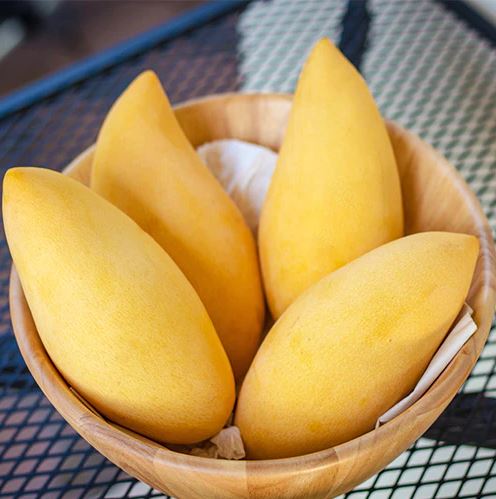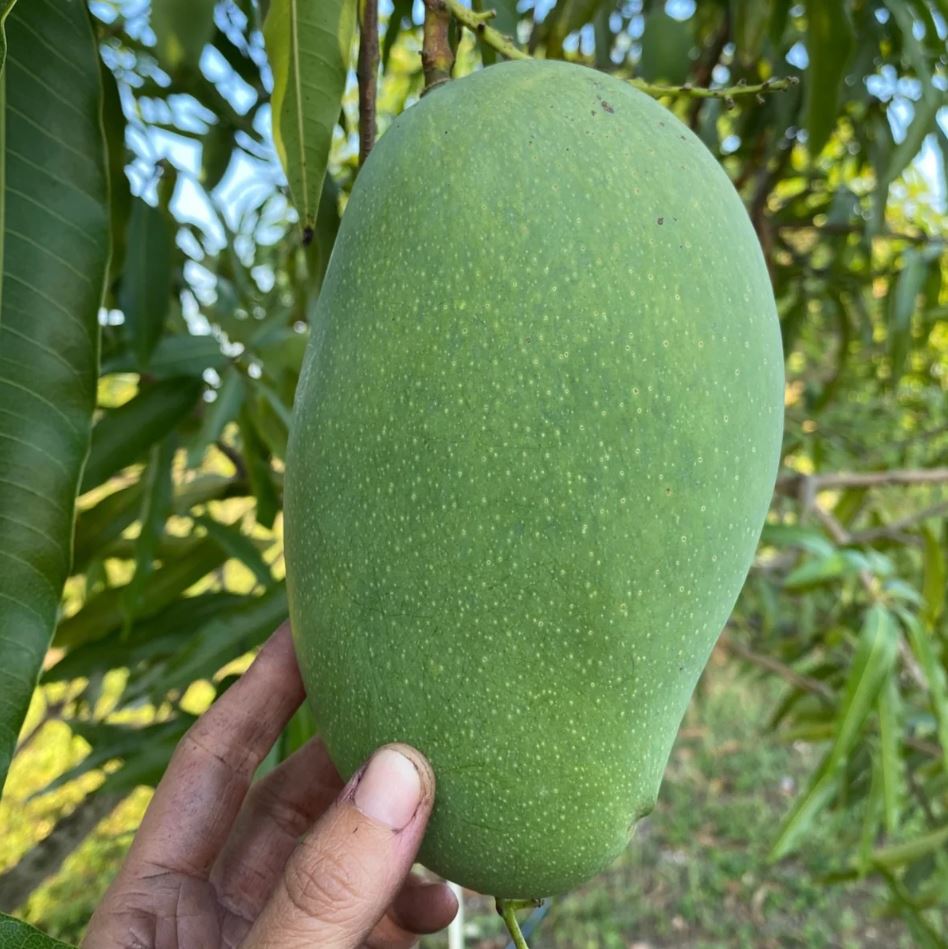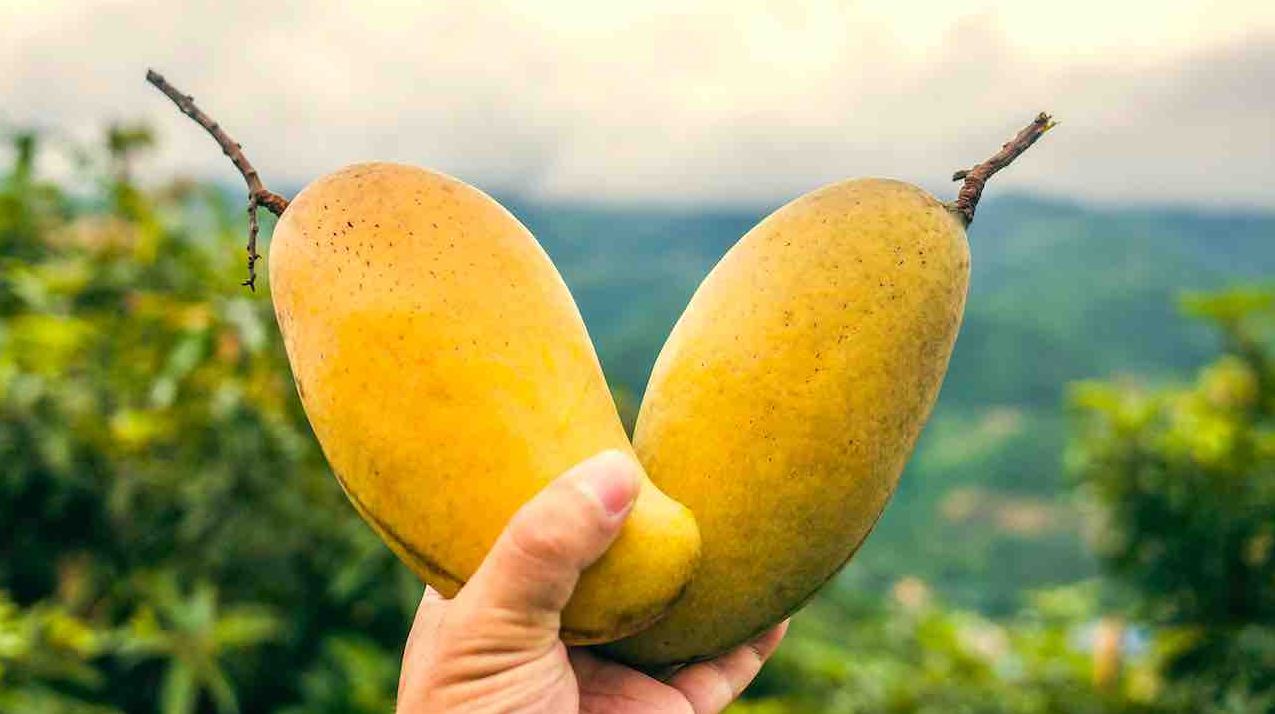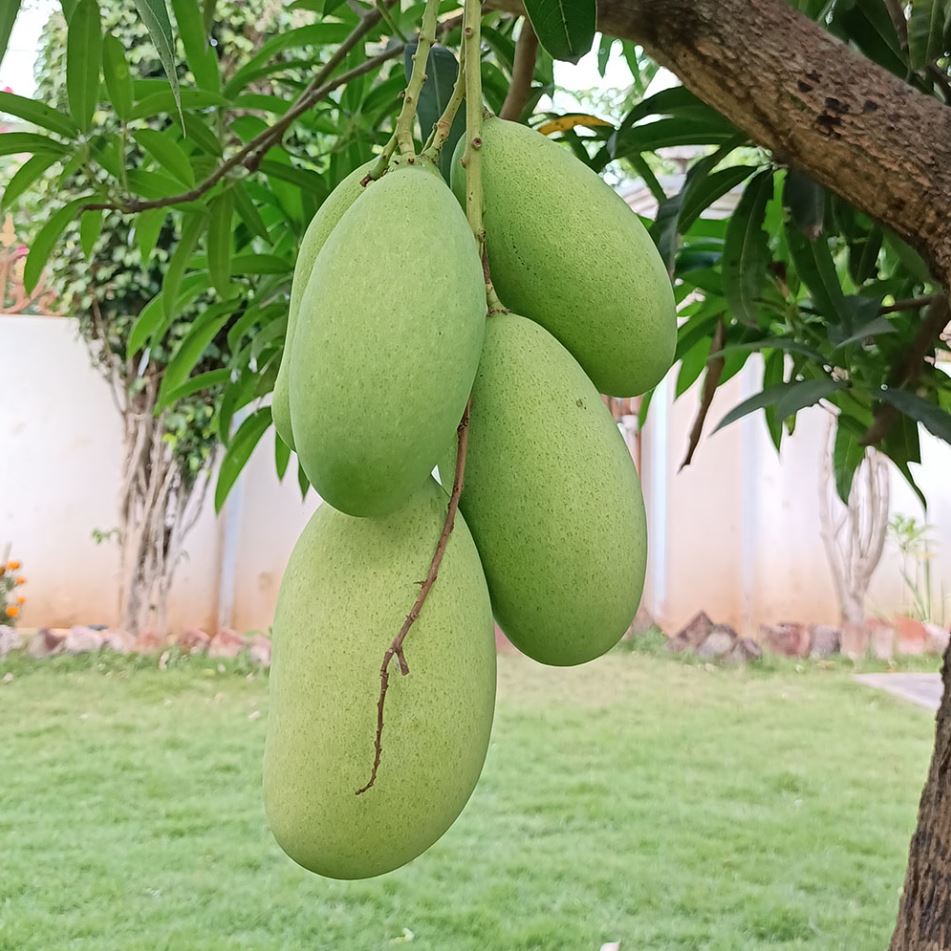Unique Qualities of the Mallika Mango A Hybrid Marvel
The ‘Mallika’ mango stands as a testament to agricultural innovation, a hybrid variety born from the fusion of two esteemed Indian mango types, Neelum and Dasheri. This creation is the brainchild of Dr. Ramnath Singh, who played a pivotal role in developing a variety that combines the best features of its parent strains. The result is a mango variety that not only excels in flavor but also adapts well to smaller, personal garden spaces, thanks to its manageable size when grafted.
Ideal for dooryard growing, the ‘Mallika’ mango tree maintains a compact stature, making it a perfect fit for garden enthusiasts who wish to cultivate fruit trees without the expansive space typically required. This characteristic allows for more personalized care and easier harvesting, bringing the joys of fruit gardening to those with limited outdoor areas.
This article delves deep into the ‘Mallika’ mango’s journey from its hybridization process to the fruit’s performance in various climatic conditions. We will explore the specific cultivation needs that ensure optimal growth and fruit production, emphasizing how regional climates affect its development and susceptibility to diseases. Additionally, the article will shed light on the fruit’s distinctive characteristics, such as its unique flavor profile marked by hints of citrus, melon, and honey, and its fiberless texture which has garnered positive reactions, notably at prestigious events like the Fairchild Botanic Gardens International Mango Festival.
Moreover, a special focus will be placed on the challenges posed by the disease known as malformation, particularly in cooler temperatures, and how it impacts fruit quality and yield. We will also track the intriguing changes in the fruit’s physical attributes and chemical makeup from the moment of harvest through the subsequent week, providing valuable insights for both consumers and cultivators. Through this comprehensive exploration, readers will gain a deeper understanding of the ‘Mallika’ mango, appreciating both its complexities and its high potential as a cultivar in both domestic and commercial contexts.
| Feature | Details |
|---|---|
| Origin | A hybrid of Neelum and Dasheri mangoes, developed by Dr. Ramnath Singh. |
| Size | Compact, suitable for personal garden spaces and dooryard growing. |
| Flavor Profile | Combines hints of citrus, melon, and honey; fiberless texture. |
| Cultivation Needs | Optimal growth conditions vary with regional climates, requires specific care to manage disease and ensure quality. |
| Challenges | Susceptible to malformation in cooler temperatures, affecting fruit quality and yield. |
| Research Focus | Investigates changes in physical attributes and chemical makeup post-harvest. |
| Acknowledgments | Noted positive reactions at the Fairchild Botanic Gardens International Mango Festival. |
Contents
Origin and Cultivation
The ‘Mallika’ mango is a distinguished hybrid, expertly developed through the cross-pollination of two prominent Indian mango varieties, Neelum and Dasheri. This strategic hybridization process was pioneered by Dr. Ramnath Singh, aiming to combine the robust features of Neelum’s resilience and the succulent, sweet flavor profile of Dasheri. The goal was to create a variety that not only thrives in diverse climatic conditions but also enhances the fruit’s taste and storage characteristics.

The successful hybridization resulted in the ‘Mallika’ mango, which when grafted, exhibits a compact growth habit. This makes it particularly suitable for dooryard gardening, where space can be a constraint. The manageable size of the tree is a significant advantage for small-scale growers or homeowners who wish to enjoy fresh mangoes directly from their gardens without the need for large orchards. Grafting, a horticultural technique used to join parts from two plants so they grow as a single plant, is particularly effective with ‘Mallika’ mangoes, as it ensures the trees remain small yet productive. This characteristic is especially beneficial in urban settings where garden space is limited, allowing more people to cultivate this exquisite fruit in their backyards or even in container gardens.
The adaptability of ‘Mallika’ to various soil types and environments coupled with its moderate water requirements simplifies the cultivation process, making it accessible to a broad range of enthusiasts from amateur gardeners to professional cultivators. This ease of growth, when combined with the tree’s restrained size, renders the ‘Mallika’ mango an ideal choice for sustainable and efficient fruit production on a smaller scale.
| Feature | Details |
|---|---|
| Hybrid Origin | Developed from cross-pollination of Neelum and Dasheri mangoes by Dr. Ramnath Singh. |
| Hybrid Goals | Combines Neelum’s resilience and Dasheri’s sweet flavor; aims to thrive in diverse climates and enhance taste and storage characteristics. |
| Growth Habit | Compact size ideal for dooryard gardening; suitable for small-scale growers and urban settings. |
| Grafting Benefits | Keeps trees small yet productive, suitable for growing in containers and limited spaces. |
| Cultivation Adaptability | Adapts to various soil types and environments, moderate water requirements, easy for a broad range of gardeners. |
Fruit Characteristics Via Video
The fruit of the ‘Mallika’ mango is celebrated for its exceptional quality and distinctive flavor, which stands out even in the rich tapestry of the mango varieties. The mangoes are fiberless, a quality highly prized for culinary use and direct consumption, as it ensures a smooth, creamy texture that melts in the mouth. The flavor of ‘Mallika’ mango is a complex amalgamation of citrus, melon, and honey notes, providing a refreshing and sweet taste that is both bold and nuanced.
The physical attributes of the ‘Mallika’ mango are equally impressive. The fruit typically features a vibrant color palette that transitions from a greenish hue when unripe to a striking reddish-yellow at full maturity. This visual appeal is matched by the mango’s substantial size and robust shape, making it not only a delight to taste but also a pleasure to behold.
At the Fairchild Botanic Gardens International Mango Festival, a venue renowned for showcasing the finest mango varieties from around the globe, the ‘Mallika’ mango received a warm reception. The festival, which attracts mango enthusiasts and experts, provided a platform for the ‘Mallika’ mango to be tasted and critiqued by a discerning audience. The feedback was overwhelmingly positive, with particular praise directed at its rich flavor and excellent texture. This reception not only underscored the mango’s appeal to connoisseurs but also highlighted its potential for commercial success in both local and international markets.
The positive reaction at the festival has helped to boost the popularity of the ‘Mallika’ mango, encouraging more people to grow and enjoy this unique variety. The acclaim it received has also spurred further interest in tropical and subtropical fruit cultivation, showcasing the potential of thoughtful hybridization in enhancing fruit quality and consumer satisfaction.
| Aspect | Details |
|---|---|
| Fruit Quality | Fiberless texture, smooth and creamy, melts in the mouth. |
| Flavor Profile | Complex blend of citrus, melon, and honey notes, providing a refreshing and sweet taste. |
| Physical Attributes | Vibrant color transition from greenish hue to reddish-yellow; substantial size and robust shape. |
| Reception at Festival | Received positive feedback at the Fairchild Botanic Gardens International Mango Festival; praised for flavor and texture. |
| Impact of Reception | Boosted popularity and interest in growing ‘Mallika’ mango; highlighted its commercial potential and encouraged tropical fruit cultivation. |
Cultivation Requirements and Climate
The ‘Mallika’ mango thrives best in tropical to subtropical climates, which provide the warm temperatures and humidity that are ideal for this fruit. These climates generally offer a consistent temperature range between 24°C to 30°C, which is crucial for the optimal development of mangoes. The warmth aids in the maturation process, enhancing the fruit’s natural sugars and flavors, while the humid atmosphere helps in the pollination process, ensuring a good fruit set.

However, when ‘Mallika’ mangoes are grown in colder climates, where temperatures frequently dip below 15°C, the trees are subjected to stress, which can adversely affect their growth and fruit production. In these cooler environments, one of the most common issues encountered is the malformation of flowers and young fruits, a condition attributed to the abnormal production of ethylene—a plant hormone typically associated with the aging and ripening of fruits.
Ethylene is also a stress hormone in plants, produced in higher quantities when they are exposed to unfavorable conditions, such as cold stress. In ‘Mallika’ mangoes, excessive ethylene production can lead to abnormal growth patterns, disrupting the normal development of floral organs. This results in malformed flowers, which are incapable of properly developing into healthy fruit, thereby significantly reducing the yield and quality of the mangoes.
| Aspect | Details |
|---|---|
| Ideal Climate | Tropical to subtropical, with consistent temperatures between 24°C to 30°C and high humidity, beneficial for maturation and pollination. |
| Impact of Cold Climates | Colder conditions (below 15°C) stress the trees, leading to reduced growth and fruit production. |
| Common Issue in Cold | Malformation of flowers and young fruits due to abnormal ethylene production, which is a stress response in plants. |
| Consequence of Excessive Ethylene | Disrupts normal floral development, resulting in malformed flowers that fail to develop into healthy fruit, reducing yield and quality. |
Disease Susceptibility
Malformation is a significant disease affecting many mango varieties, including ‘Mallika’. This disease not only distorts the physical appearance of the flowers and fruits but also impacts the overall productivity of the trees. The disease is most prevalent when the mango trees are exposed to temperature fluctuations that fall in the range of 10-15 degrees Celsius, particularly during the flowering stage.
The cause of malformation in mangoes involves complex interactions between environmental factors and physiological responses. Besides the ethylene overproduction, other biotic factors like fungal pathogens and pests can exacerbate the condition. The disease manifests in two forms: vegetative malformation, which affects the shoots and causes bushy, compact growth, and floral malformation, which affects the flowers, leading to clusters of sterile flowers that do not bear fruit.

To minimize the risks associated with malformation and other diseases, several cultivation tips can be employed:
- Temperature Management: Where possible, protecting mango trees from cold snaps through the use of windbreaks or choosing planting sites that mitigate cold exposure can help. In regions where low temperatures are common, selecting grafts from mature, disease-resistant ‘Mallika’ trees can also confer some level of hardiness against the cold.
- Pruning Practices: Regular pruning helps in removing malformed branches and flowers, which can reduce the spread of the disease and improve air circulation around the flowers and fruits. This practice also helps in reducing the overall ethylene concentration around the plant by removing parts that might be producing excessive amounts of this hormone.
- Fungicide and Pesticide Use: Application of appropriate fungicides and pesticides, following local agricultural guidelines, can help control biotic factors contributing to malformation. It’s crucial to follow a management schedule that aligns with the flowering period to protect the new flowers from infections and pests.
- Nutrient Management: Ensuring that the mango trees are well-nourished through balanced fertilization can enhance their resistance to diseases. A robust plant is less likely to succumb to environmental stresses and more capable of resisting pathogens.
By understanding and implementing these preventive measures, growers can significantly enhance the health and productivity of their ‘Mallika’ mango trees, ensuring a bountiful harvest of high-quality fruits despite the challenges posed by their growing environments.
| Aspect | Details |
|---|---|
| Disease Description | Malformation affects the physical appearance and productivity of mango trees, prevalent in temperatures of 10-15°C, particularly during the flowering stage. |
| Causes | Caused by complex interactions between environmental factors and physiological responses, including ethylene overproduction, fungal pathogens, and pests. |
| Types of Malformation | Vegetative (affects shoots, causing bushy growth) and floral (affects flowers, leading to sterile clusters). |
| Cultivation Tips | Temperature management, use of windbreaks, selection of disease-resistant grafts, regular pruning, and controlled use of fungicides and pesticides. |
| Benefits of Cultivation Practices | Improves air circulation, reduces ethylene levels, controls pathogens, and enhances disease resistance, leading to healthier trees and better fruit quality. |
Post-Harvest Changes
After being harvested, ‘Mallika’ mangoes undergo significant transformations in both their physical attributes and chemical composition, which influence their taste, texture, and storage qualities. From the first to the seventh day post-harvest, these changes are crucial for consumers and suppliers to understand to optimize the fruit’s eating quality and shelf life.
Day 1 to Day 3
Initially, the mangoes retain much of their harvest color, typically a greenish-yellow. However, within the first three days, a noticeable shift occurs. The skin begins to adopt a reddish-yellow hue, signaling the onset of ripening. This color change is due to an increase in carotenoid pigments, which replace the green chlorophyll in the skin. The fruit’s acidity is highest immediately post-harvest but starts to decrease as the natural fruit sugars develop. In terms of texture, the mango is firmest during these initial days, making it less susceptible to bruising during transportation.

Day 4 to Day 7
By the fourth day, the ‘Mallika’ mango’s sweetness intensifies as the conversion of starches to sugars continues. The texture softens progressively, reaching optimal eating quality around the fifth or sixth day. During this period, the mango also reaches its peak weight due to water retention but begins to gradually lose moisture thereafter, which leads to a slight reduction in size by the seventh day. The interplay between decreasing acidity and softening texture makes the mango particularly appealing to the palate at this stage.
| Days Post-Harvest | Physical Changes | Chemical Changes | Texture Changes |
|---|---|---|---|
| Day 1 to Day 3 | Color shifts from greenish-yellow to reddish-yellow due to increase in carotenoid pigments. | High acidity immediately post-harvest which begins to decrease as fruit sugars develop. | Firm texture, less susceptible to bruising during transportation. |
| Day 4 to Day 7 | Skin color continues to deepen; fruit begins to lose moisture by day 7, slightly reducing in size. | Sweetness intensifies as starches convert to sugars. | Texture softens, reaching optimal eating quality around day 5 or 6. |
The ‘Mallika’ mango, with its vibrant flavor and adaptability, stands out as a superior choice for both small-scale backyard growers and large-scale commercial producers. The hybrid’s origins from Neelum and Dasheri varieties provide it with a robust genetic foundation that enhances its disease resistance and flavor profile—characteristics ideal for various climates and growing conditions.
For small-scale growers, the manageable size of the grafted ‘Mallika’ mango tree makes it an attractive option for dooryard cultivation, allowing for easier management and harvesting. Commercial growers, on the other hand, can benefit from the fruit’s popularity due to its exceptional taste and the growing market demand for high-quality, fiberless mangoes.
The post-harvest changes that ‘Mallika’ mangoes undergo are particularly noteworthy. Understanding these changes can help growers, shippers, and retailers manage the fruit’s shelf life better and ensure that consumers receive the fruit at its peak quality. The initial firmness post-harvest aids in handling and shipping, while the rapid ripening process requires careful timing to maximize flavor and texture for end consumers.
For those interested in delving deeper into the cultivation, care, and benefits of the ‘Mallika’ mango, resources such as agricultural extension services, horticultural societies, or online forums specializing in tropical fruit cultivation can provide valuable insights. Additionally, visiting local botanical gardens or agricultural fairs, like the Fairchild Botanic Gardens International Mango Festival, can offer firsthand experiences with different mango varieties and expert advice on growing them.
In conclusion, whether you are a hobbyist seeking to enrich your garden with a fruit-bearing tree or a commercial producer aiming to diversify your crop offerings, the ‘Mallika’ mango offers both challenges and rewards, promising a delightful addition to any agricultural endeavor. Its combination of exquisite taste, manageable growth, and post-harvest resilience makes it a worthy candidate for any enthusiastic grower.
Ríu Ríu Chíu A Renaissance Villancico Reborn as a Beloved
Corporate Influence in Thank You for Smoking
Exploring Magdalena de Kino A Gem in Sonora, Mexico
The Storied Career of Frédéric Déhu From Lens to Barcelona
Pearl of the Orient A Journey Through History and Culture
The Diverse World of Physalis Peruviana A Comprehensive Guide
The Cassese Legacy Tracing the Impact of a Distinguished
